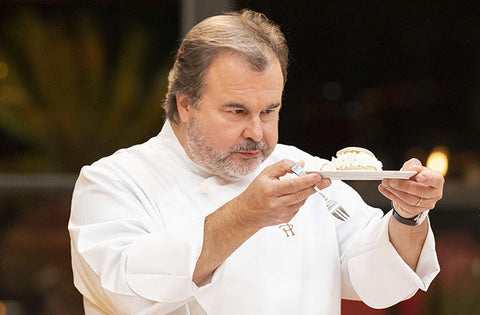Vegan pastry: trends and recipes

Vegan baking by definition excludes the use of all products of animal origin . That is to say dairy products, eggs, gelatin, as well as all products derived from animal exploitation, including honey.
It appeared around ten years ago in traditional pastries. By not using certain essential ingredients in baking, pastry chefs must demonstrate creativity and technique in order to find the right textures and offer quality products with a unique taste. It is now taught in cooking schools and attracts even the greatest chefs.
A trend that continues to rise
Vegan baking goes hand in hand with new consumption patterns . Indeed, according to the latest IPCC report , consumers are encouraged to consume more products of plant origin for ecological reasons because they would significantly reduce our greenhouse gas emissions. Other consumers have made this choice for ethical reasons (animal breeding conditions) or health reasons (allergy or intolerance).
Naturally, French pastry chefs have not let this trend escape. Many of them have imagined new vegan pastry recipes to attract these new customers. It is also, for them, an excellent way to differentiate themselves from the competition.
What raw materials are used?
Making vegan pastries is becoming less and less difficult: alternative plant-based ingredients have developed and are now easily accessible commercially and from wholesalers who supply pastries.
■ To begin with, vegetable fats : they bring softness and fondness to pastries. The choice of vegetable fat to use will depend on the desired texture.
 Example : deodorized coconut oil combined with a liquid oil such as grapeseed oil or olive oil.
Example : deodorized coconut oil combined with a liquid oil such as grapeseed oil or olive oil.
■ Plant-based drinks or plant-based milks : plant-based drinks can be made from legumes, oilseeds, cereals or plant pulp.
Examples : soy, almond, hazelnut, oat, rice or coconut milk.
■ Flours and starches : it is possible to replace the role of binder played by the egg with flours, starches and other types of natural binders.
 Examples :
Examples :
- potato starch or cornstarch,
- flax seeds and chia seeds,
- fruit compote or vegetable puree,
- mashed bananas,
- flours for thickening (chickpea, soy, lupine, oat, rice, buckwheat or chestnut)
- tofu and soy yogurt
- purees (almond, hazelnut, peanut, cashew, etc.)
- guar and xanthan gum for gluten-free recipes.
You can also find ready-made preparations on the market , which generally consist of starch, thickeners (guar gum) and emulsifier (vegetable fat).
■ Finally, plant-based gelling agents : in plant-based baking, the two gelling agents mainly used are agar-agar (from red algae) for a constant gel in the mouth and NH pectin (from the skin and seeds of fruits) for a softer jelly.
The great pioneering chefs of vegan
■ Pierre Hermé: “ It’s a technical challenge, and I like challenges ”

Pastry chef Pierre Hermé, crowned best pastry chef in the world in 2016 , now employs 650 people worldwide and sells a macaron every 30 seconds. He has published a book dedicated to vegan baking.
During an appearance on France Inter, he explained that he got into plant-based pastry following a meal at Jean-Georges Vongeritchen in New York and that one of his former colleagues had opened a plant-based pastry shop, which gave him ideas.
Consequently, the Research and Development team at Maison Pierre Hermé worked for 4 years to develop more than 60 vegan recipes. He explains: “Sometimes animal fats or eggs can mask flavors. For example, I find that the taste of chocolate is exacerbated by the fact that there is no butter, milk or cream. We have an almost purer taste of chocolate.”
For him, in the future, in a pastry shop, there will necessarily be a plant-based option, hence the importance of taking the lead.
■ Johanna Lefebvre, France’s leading plant-based pastry chef

It all started in his family vacation home in Corrèze. One summer, at just 6 years old, seeing her grandmother baking, she decided to give her a helping hand and her love for baking was born.
But reality caught up with her when she was diagnosed with an intolerance to gluten, lactose and eggs. Strength of character, she decided to settle down in Spain where gluten-free cuisine was already well established.
The click! It was the opening of Celicioso, the first 100% gluten-free and vegan pastry in Madrid, which made him decide to embark on the adventure of plant-based pastry.
Trained in the prestigious school of Alain Ducasse and Yves Thuriès and after several experiences with renowned chefs, Johanna is pursuing her dream of plant-based pastry. It was in 2015 that she created Jo and Nana Cakes, a 100% vegan and gluten-free pastry .
Vegan pastries: some recipes for inspiration
- Pierre Hermé's vegan cheesecake : https://www.elle.fr/Elle-a-Table/Recettes-de-cuisine/Cheese-cakes-vegan-de-Pierre-Herme-3080524
- Bérénice Leconte's vegan strawberry plant : YouTube tutorial here → https://www.youtube.com/watch?v=aTA5WGw2Aeo
- Frédéric Bau's sans percent : https://www.valrhona.com/fr-FR/vous-inspirer/recettes/toutes-nos-recettes/sans-pour-cent
- Amatika coconut and hazelnut by Johann Vanier : https://www.valrhona.com/fr-FR/vous-inspirer/recettes/toutes-nos-recettes/amatika-noix-de-coco-noisette
- Vegan spiced Paris pear dessert : https://www.parisdepices.com/2015/11/08/entremets-vegan-a-la-poire/
- The vegan strawberry and almond dessert by Julie from the “In search of flavors” pastry shop: https://en-quete-de-saveurs.fr/entremet-fraise-vegan/
- Vegan & gluten-free red fruit and chocolate dessert by Anaëlle Chaudier : https://www.passeportsante.net/nutrition/recettes/entremet-fruits-rouges-chocolat-vegan-sans-gluten
Plant-based baking represents much more than a simple culinary alternative, it is a real niche that responds to a new demand for healthy eating and more environmentally friendly practices.


